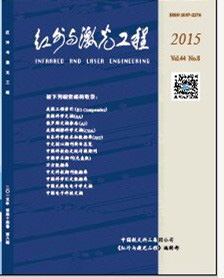|
[1]
|
|
|
[2]
|
Buller G S, Wallace A M. Ranging and three-dimensional imaging using time-correlated single-photon counting and point-by-point acquisition[J]. IEEE J Sel Top Quantum Electron, 2007, 13(4):1006-1015. |
|
[3]
|
Johnson S E. Cramer-Rao lower bound on range error for LADARs with Geiger-mode avalanche photodiodes[J].Applied Optics, 2010, 49(24):4581-4590. |
|
[4]
|
|
|
[5]
|
Philip Gatt, Steven Johnson, Terry Nichols. Dead-time effects on Geiger-Mode APD performance[C]//SPIE, 2007, 6550:65500I-1-65500I-12. |
|
[6]
|
|
|
[7]
|
|
|
[8]
|
He Weiji, Sima Boyu, Chen Qian, et al. Photon-counting imaging based on Geiger-Mode APD[J]. Optics and Precision Engineering, 2012, 20(8):1343-1349.(in Chinese)何伟基, 司马博羽, 陈钱, 等. 基于盖格-雪崩光电二极管的光子计数成像[J]. 光学精密工程, 2012, 20(8):1343-1349. |
|
[9]
|
|
|
[10]
|
Min Seok Oh, Hong Jin Kong, Tae Hoon Kim. Reduction of range walk error in direct detection laser radar using a Geiger mode avalanche photodiode[J]. Optics Communications, 2010, 283(2):304-308. |
|
[11]
|
Pellegrini S, Buller G S, Smith J M, et al. Laser-based distance measurement using picosecond resolution time-correlated single photon Counting[J]. Meas Sci Technol, 2000, 11:712-716. |
|
[12]
|
|
|
[13]
|
McCarthy A, Collins R J, Krichel N J. Long-range time-of flight scanning sensor based on high-speed time-correlated single-photon counting[J]. Applied Optics, 2009, 48(32):6241-6251. |
|
[14]
|
|
|
[15]
|
|
|
[16]
|
Jiang Haijiao, Lai Jiancheng, Wang Chunyong, et al. Research on ranging property of laser radar and its range accruacy[J]. Chinese Journal of Lasers, 2011, 39(4):0514001-1-0414001-7.(in Chinese)姜海娇, 来建成, 王春勇, 等. 激光雷达的测距特性及其测距精度研究[J]. 中国激光, 2011, 39(4):0514001-1-0414001-7. |
|
[17]
|
|
|
[18]
|
Xu Lu, Zhang Yu, Zhang Yong, et al. Research on the detection performance of Geiger-Mode APD laser radar with accumulated detection[J]. Chinese Journal of Lasers, 2012, 39(4):0414003-1-0414003-6.(in Chinese)徐璐, 张宇, 张勇, 等. 盖革模式雪崩光电二极管激光雷达累积探测性能的研究[J]. 中国激光, 2012, 39(4):0414003-1-0414003-6. |
|
[19]
|
Liu Chenghao, Chen Yunfei, He Weiji, et al. Simulation and accuracy analysis of single photon ranging system[J]. Infrared and Laser Engineering, 2014, 43(2):383-387.(in Chinese)刘骋昊, 陈云飞, 何伟基, 等. 单光子测距系统仿真及精度分析[J]. 红外与激光工程, 2014, 43(2):383-387. |
|
[20]
|
|
|
[21]
|
Shen Shanshan, Chen Qian, He Weiji, et al. Resaerch on performance of random bitstream ranging system based on single photon detection theory[J]. Acta Optica Sinica, 2014, 34(10):1012001-1-1012001-6.(in Chinese)沈姗姗, 陈钱, 何伟基, 等. 基于单光子探测机理的伪随机码测距性能研究[J]. 光学学报, 2014, 34(10):1012001-1-1012001-6. |
|
[22]
|
|
|
[23]
|
|
|
[24]
|
Steven Johnson, Philip Gatt, Terry Nichols. Analysis of Geiger-Mode APD laser radars[C]//SPIE, 2003, 5086:359-368. |
|
[25]
|
|
|
[26]
|
Ye Shunliu, Zhi Shaolan, Sun Qibing, et al. Application of pseudo-random sequence in lidar ranging[C]//ICIECS, 2009:5364645. |
|
[27]
|
|
|
[28]
|
Wang Fei, Zhao Yuan, Zhang Yu, et al. Range accuracy limitation of pulse ranging aystems based on Geiger mode aingle photon setectors[J]. Applied Optics, 2010, 49(29):5561-5566. |
|
[29]
|
Philip Gatt, Steven Johnson, Terry Nichols. Geiger-mode avalanche photodiode ladar receiver performance characteristics and detection statistics[J]. Applied Optics, 2009, 48(17):3261-3275. |
|
[30]
|
|
|
[31]
|
Cantor B I, Teicht M C. Dead-time-corrected photon counting distributions for laser radiation[J]. Journal of the Optical Society of America, 1975, 65(7):786-791. |
|
[32]
|
|
|
[33]
|
Lars Sjoqvist, Christina Gronwall, Markus Henriksson, et al. Atmospheric turbulence effects in single-photon counting time-of-flight range profiling[C]//SPIE, 2008, 7115:71150G-1. |









 DownLoad:
DownLoad: